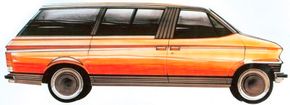The 1972 Ford Carousel minivan concept car just barely missed a chance steal a beat on Chrysler and tap a large latent market for family haulers.
Chrysler Corporation likes to boast that its 1984 Dodge Caravan/Plymouth Voyager pioneered the minivan concept, but that's only true of front-wheel-drive designs. The real originator was Volkswagen, which had sold rear-drive minivans since the early 1950s in the Beetle-based Type 2 Microbus (through 1979) and the later Vanagon.
Advertisement
There was also Chevrolet, which had imitated VW for 1961 with a trio of trucks derived from its compact Corvair, another air-cooled rear-engine car. Besides a novel pickup called Rampside, Chevy offered Corvan commercial and Greenbrier passenger vans remarkably similar in size and shape to the Chrysler models of nearly a quarter-century later.
That same year, 1961, Ford trotted out a group of Falcon-based compact trucks called Econoline: initially a pickup, commercial van, and windowed passenger van. All had conventional rear drive and boxy "cab-over-engine" bodywork like the VWs and Chevys, but hewed to orthodoxy with water-cooled six-cylinder engines mounted in front.
Simple and reliable, Econoline sold well from the first, easily outpacing the more trouble-prone Corvan/Greenbrier. It also outlasted them in the marketplace. Almost predictably, though, Econoline grew quite a bit larger when first redesigned for 1968.
Then again, the truck market itself was growing -- and subdividing, just as automotive classes had done with compacts, intermediates, and personal-luxury models. When buyers began clamoring for utility vehicles in the image of the wartime Jeep, Ford obliged them with the Bronco for 1966.
Meanwhile, custom vans had become the rage with many younger people of the "hippie" stripe, and commercial users were demanding bigger, heftier vans as well as pickups. That set Ford to working on an even larger Econoline. Developed as project "Nantucket," this third-generation design was pretty much locked up by 1972. Introduction was slated for model-year 1975.
But something else was afoot, or so thought one Lido Anthony Iacocca, the former super-salesman from Pennsylvania who had fast climbed the ladder at Ford Motor Company to become its president in 1970.
That presidency was partly his reward for "fathering" the original Mustang ponycar and some newer Dearborn winners. Of course, Iacocca wasn't solely responsible for the Mustang's huge success, as he (and others) liked to claim, but he could spot emerging market trends.
Learn more about Iacocca's ideas for a minivan by continuing to the next page.
For more on concept cars and the production models they forecast, check out:
- Concept Cars
- Classic Cars
- Consumer Guide auto show reports
- Future Cars
Advertisement





